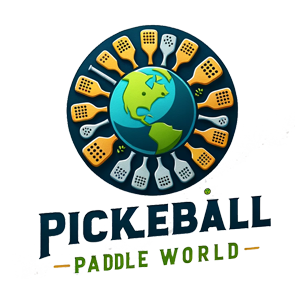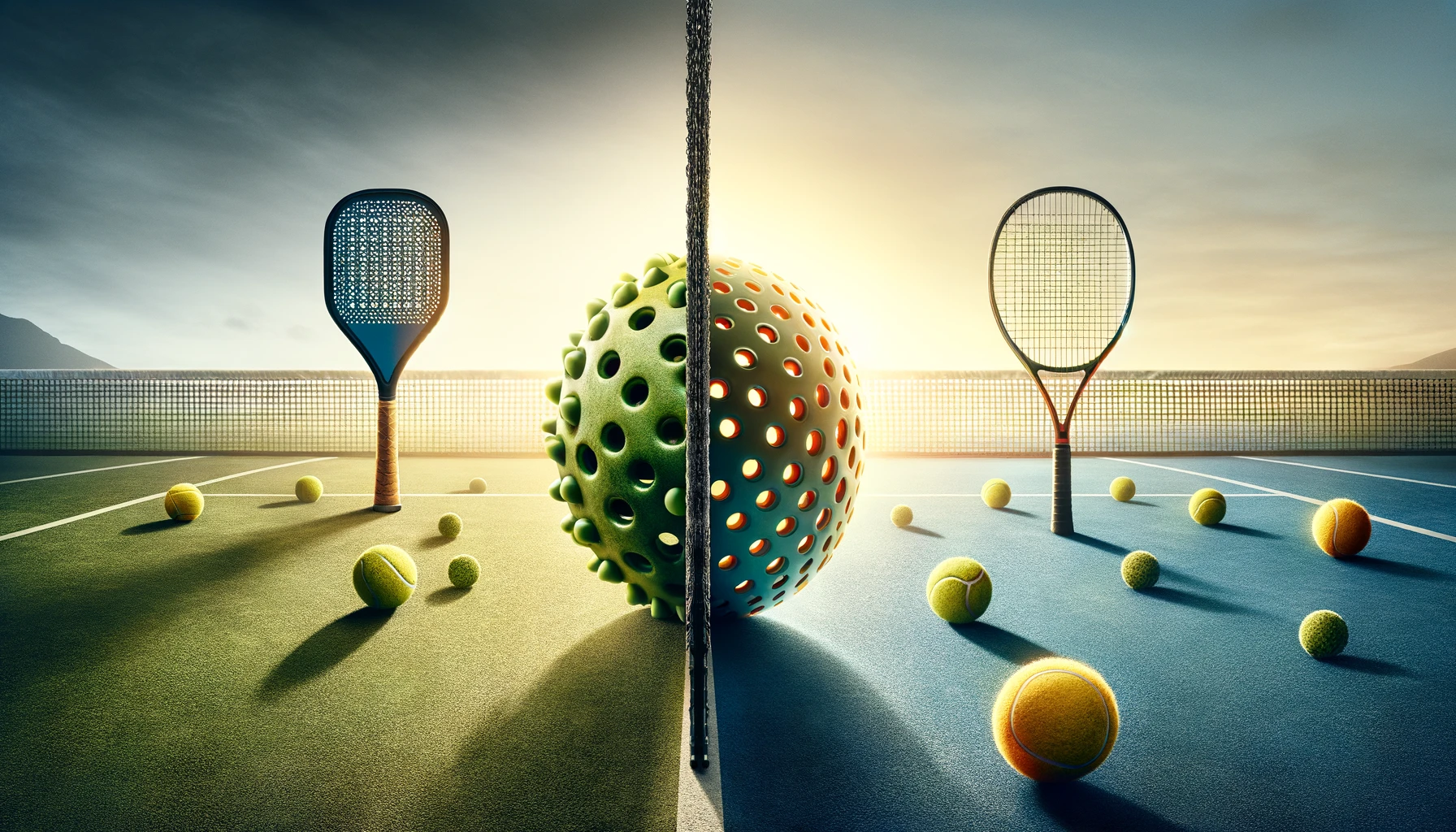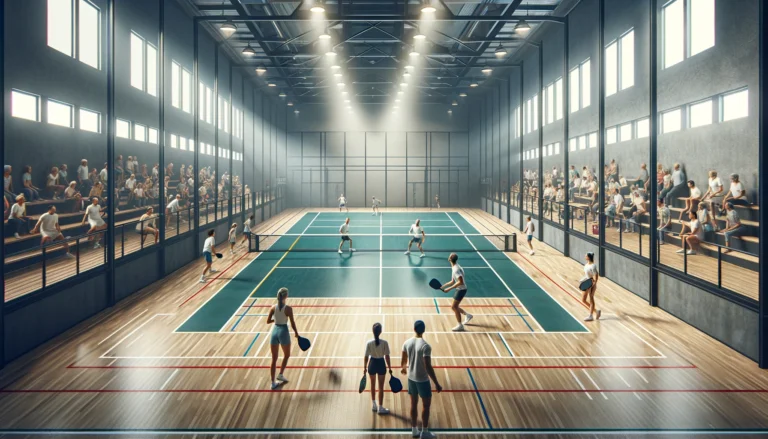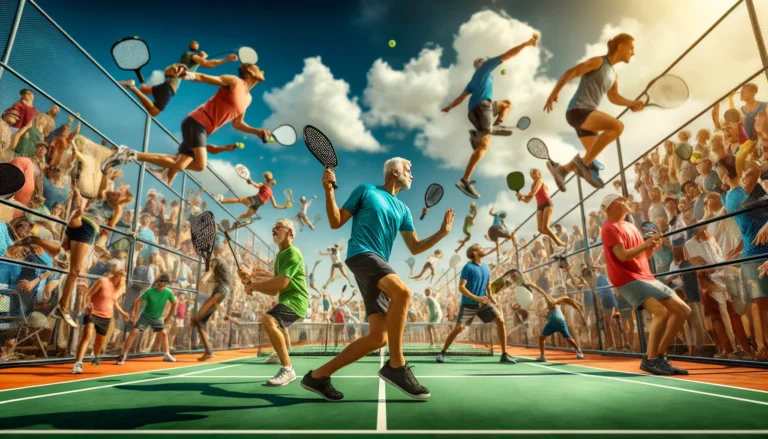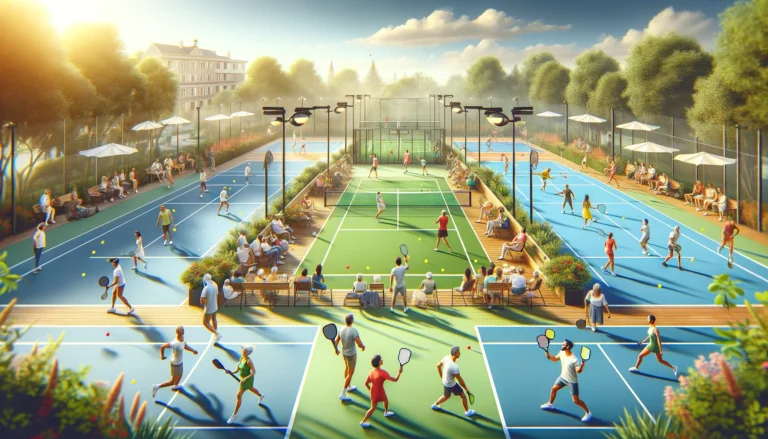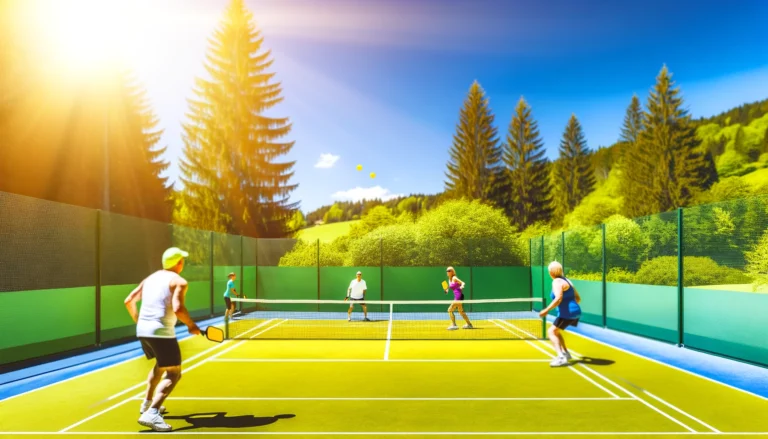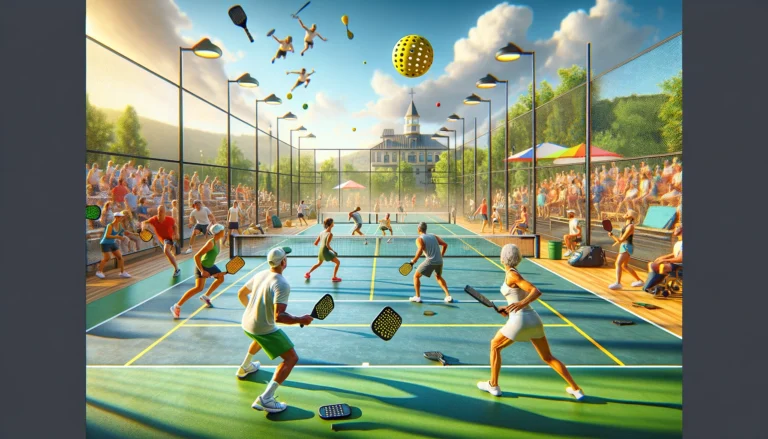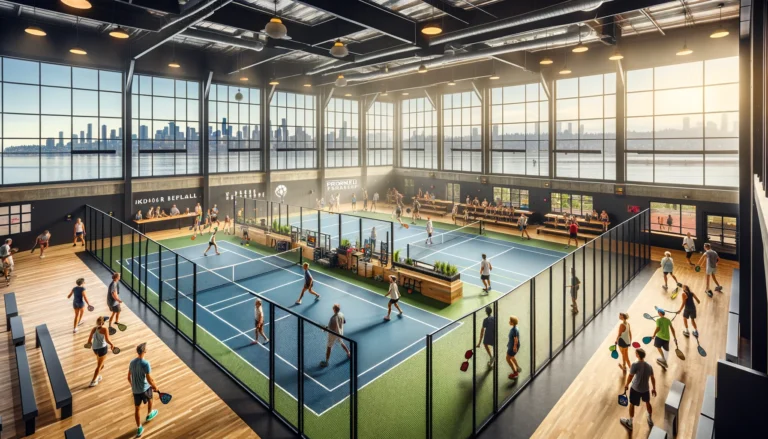What is the difference between pickleball and tennis? Exploring the Key Differences and Similarities
Introduction
In recent years, the sports landscape has seen the rise of a new contender vying for the attention and affection of racquet sport enthusiasts: pickleball. This intriguing game, with its unique name and engaging gameplay, has swiftly climbed the ranks of recreational activities, drawing comparisons to the well-established and globally revered sport of tennis. But what exactly sets these two apart? At first glance, pickleball and tennis appear to share a host of similarities, from the basic use of a net to the back-and-forth volley of a ball. However, as many players would attest, the devil is in the details. What is the difference between pickleball and tennis? This question not only piques the curiosity of newcomers but also sparks lively debates among aficionados of both sports.
Both pickleball and tennis offer a blend of strategy, physical exertion, and social interaction, making them appealing to a broad spectrum of players across all ages. Yet, despite their shared attributes, they cater to different preferences, skill sets, and even lifestyles. In this article, we delve deep into the heart of both sports, exploring their histories, equipment, gameplay, and cultural impact. Our journey will uncover the nuanced distinctions and celebrate the similarities that make pickleball and tennis beloved by millions around the globe.
As we embark on this comparative analysis, remember that the essence of this exploration goes beyond mere rules and regulations. It’s about understanding the spirit of each game, the community and culture it fosters, and ultimately, the unique joy it brings to those who step onto the court. Whether you’re a seasoned tennis player intrigued by the rising popularity of pickleball, a pickleball enthusiast curious about tennis, or a newcomer to racquet sports altogether, this guide promises to illuminate the key differences and similarities between these two captivating games.
Stay tuned as we serve up an engaging comparison that aims to answer the burning question: What is the difference between pickleball and tennis? Through this exploration, we hope not only to inform but also to inspire you to pick up a racquet and experience the joy of these sports firsthand.
Historical Background
Pickleball
The origins of pickleball can be traced back to the summer of 1965 on Bainbridge Island, near Seattle, Washington. It was born out of sheer creativity and a bit of boredom. Joel Pritchard, Bill Bell, and Barney McCallum, three dads looking to entertain their families, improvised a game using ping-pong paddles and a perforated plastic ball. The initial goal was simple: create a game that family members of all ages could enjoy together. The net was lowered to badminton height, and thus, pickleball was born—a hybrid that borrows elements from tennis, badminton, and table tennis.
From these humble beginnings in a backyard, pickleball has evolved into a sport with its own official governing body, the USA Pickleball Association (USAPA), established in 1984. The sport has grown exponentially, both in the United States and internationally, with thousands of courts available and competitions that attract players from around the world. This evolution from a family pastime to an organized sport with international competitions highlights its wide appeal and adaptability.
Tennis
Tennis, by contrast, has a much longer and more storied history, with its roots going back to 12th century France. Initially, it was played without rackets, using the palm of the hand; hence it was called “jeu de paume” (game of the palm). Over the centuries, it evolved, with rackets being introduced in the 16th century, and the game resembling more of what we know as tennis today. The modern game of lawn tennis that we are familiar with was codified in England in the late 19th century.
The global spread and cultural significance of tennis have been phenomenal. It quickly became a staple of athletic competitions worldwide, with the establishment of the four Grand Slam tournaments: the Australian Open, the French Open, Wimbledon, and the US Open. Tennis not only became a marker of athletic prowess but also a symbol of social status and refinement. Today, it holds a prominent place in the global sports arena, celebrated for its rich history, cultural significance, and the sheer level of skill and physicality required at the professional level.
Equipment and Gear
Pickleball
Pickleball equipment is designed with accessibility in mind, making it easy for beginners to pick up the game. Players use a solid paddle made of wood or composite materials, significantly larger than a ping-pong paddle but smaller than a tennis racket. The ball used in pickleball is unique; it’s a lightweight, durable plastic ball with holes, similar to a wiffle ball, which facilitates easy volleying and control. The net and court are smaller than those used in tennis, contributing to a game that is less physically demanding and more accessible to people of all ages and skill levels. This ease of entry and the minimal gear required have helped pickleball spread rapidly across communities.
Tennis
In tennis, the equipment is more specialized and varies greatly to suit different playing styles and surfaces. The racket, larger than a pickleball paddle, is made from a mix of materials including carbon fiber, which offers players a blend of power and control. Tennis balls are pressurized and covered in felt, designed to bounce on various court surfaces, including clay, grass, and hard court. The diversity in equipment, from rackets to shoes tailored for different court surfaces, reflects the game’s complexity and the nuanced preferences of players. This specialization in gear, while allowing for a highly tailored playing experience, also means a higher entry cost and investment for players, contrasting with pickleball’s more accessible nature.
The contrast in equipment between pickleball and tennis not only highlights the differences in gameplay and accessibility but also reflects the distinct cultures and communities that have formed around each sport.
Court Specifications
Pickleball
A standard pickleball court measures 20 feet in width and 44 feet in length, mirroring the dimensions of a badminton court. This size applies to both singles and doubles play, making pickleball courts notably smaller than tennis courts. The most distinctive feature of a pickleball court is the non-volley zone, affectionately known as “the kitchen.” This area extends 7 feet from the net on both sides, and players are prohibited from volleying the ball within this zone. The purpose of the kitchen is to prevent players from dominating the game by smashing the ball at close range, encouraging a more strategic and less power-driven approach.
Tennis
Tennis courts are larger, measuring 78 feet in length. The width varies: 27 feet for singles matches and 36 feet for doubles. This variation in size accommodates the additional players in doubles matches, allowing for a wider range of play and strategies. Tennis courts come in three main surface types: clay, grass, and hard court. Each surface affects ball speed and player movement differently. Clay courts slow down the ball and produce a high bounce, favoring baseline players. Grass courts, being the fastest type, benefit players with strong serve and volley skills. Hard courts offer a middle ground, providing a balanced playing field that does not significantly favor any particular style of play.
Rules and Scoring
Pickleball
In pickleball, the serving side must serve underhand, and the serve must clear the non-volley zone, including the kitchen line. Unique to pickleball is the two-bounce rule: the ball must bounce once on each side before volleys are allowed. This rule encourages longer rallies and strategic play. Scoring is typically to 11 points, and a team must win by 2 points. Games can be played as singles or doubles, and only the serving side can score points. This scoring method adds a layer of strategy to serving and forces players to be more defensive when their opponents serve.
Tennis
Tennis employs a more complex scoring system, with games, sets, and matches. Points in a game are scored as 15, 30, 40, and game, with deuce occurring at 40-40. Players must win by two consecutive points after deuce. A set is won by the first player or team to win six games, provided they are two games ahead. If the set reaches a 6-6 tie, a tiebreak is played in most formats. Matches are typically best of three or five sets, depending on the competition. The serve in tennis is a powerful weapon, and players can serve overhand, adding speed and complexity to the game. Faults occur when the serve fails to land in the correct box or if the player commits a foot fault.
The variations in court specifications and rules between pickleball and tennis significantly influence the gameplay, strategy, and physical demands of each sport. While both games require agility, coordination, and tactical thinking, the specific characteristics of each set them apart, catering to a wide range of preferences and play styles.
Gameplay Dynamics
Pickleball
Pickleball is characterized by its fast-paced, yet accessible gameplay. The smaller court size reduces the amount of ground players must cover, making it easier for people of all ages and skill levels to participate. However, this does not mean the game lacks depth; strategic placement of shots, mastering the soft game, and understanding when to engage in volleys are crucial. Games typically last around 15 to 25 minutes, making pickleball matches quick and engaging. A significant aspect of pickleball is its emphasis on social interaction and community. The sport is known for its friendly, inclusive environment, where laughter and camaraderie are as much a part of the game as the competition itself.
Tennis
Tennis demands a high level of physical intensity and skill, with matches varying greatly in duration—from 30 minutes for a quick set to several hours for a five-set marathon at the professional level. The game’s strategic complexity is evident in player styles, point construction, and the psychological battle of outmaneuvering an opponent. Physical endurance and skill level are paramount, as players must be able to serve powerfully, return accurately, and engage in long rallies. Tennis offers a dynamic range of play, from the baseline power game to the finesse of serve-and-volley, each requiring a deep understanding of the sport’s nuances.
Cultural and Social Impact
Pickleball
Pickleball’s appeal spans a wide range of ages and skill levels, contributing to its rapid growth as a community-centric sport. It has become especially popular among seniors looking for a social, low-impact form of exercise, yet it’s equally embraced by younger generations for its competitive edge and social nature. The COVID-19 pandemic further amplified pickleball’s growth, as its outdoor play and social distancing-friendly rules made it an ideal activity. This surge in popularity has fostered a strong sense of community among players, with local clubs, leagues, and tournaments fostering connections and friendships.
Tennis
Tennis holds a prestigious position as a global sport, marked by its inclusion in the Olympics and the renown of its Grand Slam tournaments. These events not only showcase the pinnacle of athletic achievement but also serve as cultural touchstones, bringing together diverse international audiences. The influence of professional players—icons like Roger Federer, Serena Williams, and Rafael Nadal—extends beyond the court, shaping fashion, lifestyle, and even social issues. Their impact has elevated the sport’s profile, inspiring generations of players and fans alike.
Similarities Between Pickleball and Tennis
Despite their differences, pickleball and tennis share several core aspects. Both sports revolve around the basic aim of striking a ball over a net and within the boundaries of the opponent’s side of the court, requiring precision, timing, and strategic foresight. Scoring in both games demands a lead of at least two points to secure a win, introducing a tactical layer to managing game points and match strategy. Hand-eye coordination, a fundamental skill for racquet sports, is essential, as is the ability to anticipate and react to opponents’ shots. Strategic play, involving the construction of points and exploiting opponents’ weaknesses, is at the heart of both sports, making them not just physical but also mental contests.
By exploring the dynamics, cultural significance, and shared attributes of pickleball and tennis, we gain a deeper appreciation for what makes each sport unique while acknowledging the qualities that unite them as beloved racquet sports.
Differences Highlighted
When exploring what is the difference between pickleball and tennis, it’s clear that while both sports share a fundamental framework, their distinct elements carve out unique niches within the racquet sports landscape. The differences between them can be observed across various dimensions such as gameplay, equipment, and cultural impact.
Gameplay: Pickleball is characterized by a smaller court size and a unique non-volley zone known as “the kitchen,” which prohibits players from executing volleys close to the net. This leads to a game that emphasizes strategic shot placement over power. Tennis, with its larger court and allowance for powerful serves and volleys, demands a higher degree of physical stamina and offers a broader scope for strategic diversity, from baseline rallies to serve-and-volley tactics.
Equipment: The equipment in pickleball and tennis also reflects their gameplay differences. Pickleball uses lightweight paddles and plastic balls with holes, facilitating a game that is accessible to players of all ages and skill levels. Tennis equipment, including stringed rackets and felt-covered rubber balls, allows for a wide range of shots and techniques, requiring more specialized skills and physical capabilities.
Culture: Culturally, pickleball has rapidly grown into a community-focused sport known for its inclusivity and social engagement. It appeals to a broad demographic, including seniors seeking low-impact physical activity and younger players enjoying competitive play. Tennis, with its centuries-old history, has a more formalized global presence, highlighted by prestigious tournaments and professional athletes who influence fashion, lifestyle, and social issues. Tennis’s cultural impact extends beyond the sport itself, embodying tradition, elegance, and athletic excellence.
Conclusion
Throughout this exploration of pickleball and tennis, we’ve uncovered the rich histories, distinct gameplay dynamics, equipment nuances, and cultural significances that define and differentiate these beloved sports. From the compact, strategic nature of pickleball with its emphasis on community and accessibility to the physically demanding, strategic depth of tennis celebrated on a global stage, each sport offers unique attractions to its participants.
Understanding the distinctive characteristics of pickleball and tennis enriches our appreciation for both sports. It highlights the diverse appeal of racquet sports, catering to various preferences, lifestyles, and skill levels. Whether one enjoys the fast-paced, strategic exchanges of pickleball or the athletic rigor and tradition of tennis, both games share the power to bring people together, foster communities, and promote physical wellness and strategic thinking.
As we reflect on the differences and similarities between pickleball and tennis, let us celebrate the varied ways they enhance the lives of players around the world. The ongoing dialogue about these sports not only broadens our perspective but also underscores the universal love for the game—regardless of the court size, equipment, or rules. In recognizing the unique contributions of pickleball and tennis to the sports world, we acknowledge the rich tapestry of activities that enrich our communities and individual experiences, encouraging everyone to engage in the joy of play.
